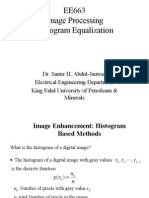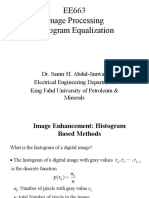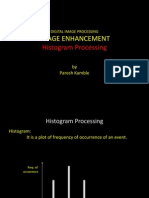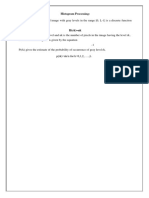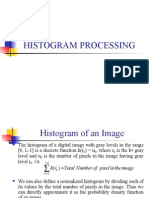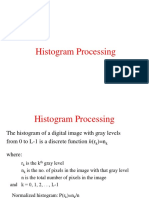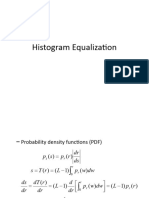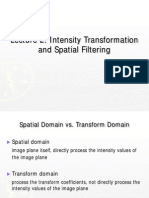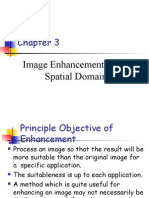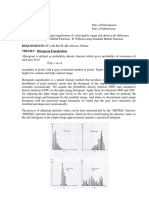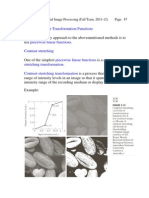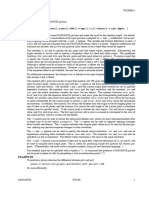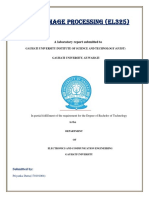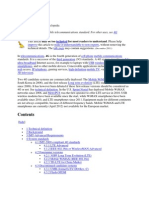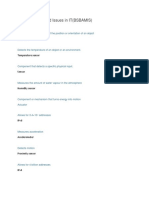Histogram Equalization
Histogram Equalization
Uploaded by
srinuindian007Copyright:
Available Formats
Histogram Equalization
Histogram Equalization
Uploaded by
srinuindian007Original Description:
Copyright
Available Formats
Share this document
Did you find this document useful?
Is this content inappropriate?
Copyright:
Available Formats
Histogram Equalization
Histogram Equalization
Uploaded by
srinuindian007Copyright:
Available Formats
EE663
Image Processing
Histogram Equalization
Dr. Samir H. Abdul-Jauwad
Electrical Engineering Department
King Fahd University of Petroleum &
Minerals
Image Enhancement: Histogram
Based Methods
- The histogram of a digital image with gray values
1 1 0
, , ,
L
r r r
is the discrete function
n
n
r p
k
k
= ) (
n
k
: Number of pixels with gray value r
k
n: total Number of pixels in the image
- The function p(r
k
) represents the fraction of the total number
of pixels with gray value r
k
.
What is the histogram of a digital image?
- Histogram provides a global description of the appearance of
the image.
- If we consider the gray values in the image as realizations of a
random variable R, with some probability density, histogram
provides an approximation to this probability density. In other
words,
) ( ) Pr(
k k
r p r R ~ =
Some Typical Histograms
- The shape of a histogram provides useful information for
contrast enhancement.
Dark image
Bright image
Low contrast image
High contrast image
Histogram Equalization
- Let us assume for the moment that the input image to be
enhanced has continuous gray values, with r = 0 representing
black and r = 1 representing white.
- We need to design a gray value transformation s = T(r), based
on the histogram of the input image, which will enhance the
image.
- What is the histogram equalization?
- The histogram equalization is an approach to enhance a given
image. The approach is to design a transformation T(.) such that
the gray values in the output is uniformly distributed in [0, 1].
- As before, we assume that:
(1) T(r) is a monotonically increasing function for
0 s r s 1 (preserves order from black to white).
(2) T(r) maps [0,1] into [0,1] (preserves the range of allowed
Gray values).
- Let us denote the inverse transformation by r = T
-1
(s) . We
assume that the inverse transformation also satisfies the above
two conditions.
- We consider the gray values in the input image and output
image as random variables in the interval [0, 1].
- Let p
in
(r) and p
out
(s) denote the probability density of the
Gray values in the input and output images.
- If p
in
(r) and T(r) are known, and r = T
-1
(s) satisfies
condition 1, we can write (result from probability theory):
) (
1
) ( ) (
s T r
in out
ds
dr
r p s p
=
(
=
- One way to enhance the image is to design a transformation
T(.) such that the gray values in the output is uniformly
distributed in [0, 1], i.e. p
out
(s) = 1, 0 s s s1
- In terms of histograms, the output image will have all
gray values in equal proportion .
- This technique is called histogram equalization.
-Consider the transformation
1 0 ) ( ) (
,
0
s s = =
}
r dw w p r T s
r
in
- Note that this is the cumulative distribution function (CDF)
of p
in
(r) and satisfies the previous two conditions.
- From the previous equation and using the fundamental
theorem of calculus,
) (r p
dr
ds
in
=
Next we derive the gray values in the output is uniformly
distributed in [0, 1].
- Therefore, the output histogram is given by
| | 1 0 , 1 1
) (
1
) ( ) (
) (
) (
1
1
s s = =
(
=
=
s
r p
r p s p
s T r
s T r
in
in out
- The output probability density function is uniform,
regardless of the input.
- Thus, using a transformation function equal to the CDF of
input gray values r, we can obtain an image with uniform gray
values.
- This usually results in an enhanced image, with an increase
in the dynamic range of pixel values.
Step 1:For images with discrete gray values, compute:
n
n
r p
k
k in
= ) (
1 0 s s
k
r 1 0 s s L k
L: Total number of gray levels
n
k
: Number of pixels with gray value r
k
n: Total number of pixels in the image
Step 2: Based on CDF, compute the discrete version of the
previous transformation :
=
= =
k
j
j in k k
r p r T s
0
) ( ) (
1 0 s s L k
How to implement histogram equalization?
Example:
- Consider an 8-level 64 x 64 image with gray values (0, 1, ,
7). The normalized gray values are (0, 1/7, 2/7, , 1). The
normalized histogram is given below:
NB: The gray values in output are also (0, 1/7, 2/7, , 1).
Gray value
# pixels
Normalized gray value
Fraction
of # pixels
- Applying the transformation,
=
= =
k
j
j in k k
r p r T s
0
) ( ) (
we have
- Notice that there are only five distinct gray levels --- (1/7, 3/7,
5/7, 6/7, 1) in the output image. We will relabel them as (s
0
,
s
1
, , s
4
).
- With this transformation, the output image will have
histogram
Histogram of output image
# pixels
Gray values
- Note that the histogram of output image is only approximately,
and not exactly, uniform. This should not be surprising, since there
is no result that claims uniformity in the discrete case.
Example
Original image and its histogram
Histogram equalized image and its histogram
- Comments:
Histogram equalization may not always produce desirable
results, particularly if the given histogram is very narrow. It
can produce false edges and regions. It can also increase
image graininess and patchiness.
Histogram Specification
(Histogram Matching)
- Histogram equalization yields an image whose pixels are (in
theory) uniformly distributed among all gray levels.
- Sometimes, this may not be desirable. Instead, we may want a
transformation that yields an output image with a pre-specified
histogram. This technique is called histogram specification.
- Given Information
(1) Input image from which we can compute its histogram .
(2) Desired histogram.
- Goal
Derive a point operation, H(r), that maps the input image into
an output image that has the user-specified histogram.
- Again, we will assume, for the moment, continuous-gray
values.
Input
image
Uniform
image
Output
image
s=T(r) v=G(z)
z=H(r)
Approach of derivation
= G
-1
(v=s=T(r))
- Suppose, the input image has probability density in p(r) . We
want to find a transformation z = H (r) , such that the probability
density of the new image obtained by this transformation is p
out
(z) ,
which is not necessarily uniform.
This gives an image with a uniform probability density.
- First apply the transformation
1 0 ) ( ) (
,
0
s s = =
}
r dw w p r T s
r
in
- If the desired output image were available, then the following
transformation would generate an image with uniform density:
1 0 ) ( ) (
,
0
s s = =
}
z dw w p z G V
z
out
(**)
(*)
- From the gray values v we can obtain the gray values z by
using the inverse transformation, z = G
-1
(v)
will generate an image with the specified density out p(z) ,
from an input image with density in p(r) !
- If instead of using the gray values v obtained from (**), we
use the gray values s obtained from (*) above (both are
uniformly distributed ! ), then the point transformation
Z=H(r)= G
-1
[ v=s =T(r)]
- For discrete gray levels, we have
=
= =
k
j
j in k k
r p r T s
0
) ( ) (
1 0 s s L k
k
k
j
j out k k
s z p z G v = = =
=0
) ( ) (
1 0 s s L k
- If the transformation z
k
G(z
k
) is one-to-one, the inverse
transformation s
k
G
-1
(s
k
) , can be easily determined, since
we are dealing with a small set of discrete gray values.
- In practice, this is not usually the case (i.e., ) z
k
G(z
k
) is not
one-to-one) and we assign gray values to match the given
histogram, as closely as possible.
Algorithm for histogram specification:
(1) Equalize input image to get an image with uniform
gray values, using the discrete equation:
=
= =
k
j
j in k k
r p r T s
0
) ( ) (
1 0 s s L k
(2) Based on desired histogram to get an image with
uniform gray values, using the discrete equation:
k
k
j
j out k k
s z p z G v = = =
=0
) ( ) (
1 0 s s L k
(3)
)] ( [ ) (
1 1
r T G z
v=s
G z
= =
Example:
- Consider an 8-level 64 x 64 previous image.
Gray value
# pixels
- It is desired to transform this image into a new image, using a
transformation Z=H(r)= G
-1
[T(r)], with histogram as specified
below:
Gray values
# pixels
- The transformation T(r) was obtained earlier (reproduced
below):
- Now we compute the transformation G as before.
- Computer z=G
-1
(s), Notice that G is not invertible.
G
-1
(0) = ?
G
-1
(1/7) = 3/7
G
-1
(2/7) = 4/7
G
-1
(4/7) = ?
G
-1
(5/7) = 5/7
G
-1
(6/7) = 6/7
G
-1
(1) = 1
G
-1
(3/7) = ?
- Combining the two transformation T and G
-1
, compute
z=H(r)= G
-1
[v=s=T(r)]
- Applying the transformation H to the original image yields an
image with histogram as below:
- Again, the actual histogram of the output image does not exactly
but only approximately matches with the specified histogram. This
is because we are dealing with discrete histograms.
Original image and its histogram
Histogram specified image and its histogram
Desired histogram
You might also like
- Rethinking Engineering Education at The Age of Industry 5.0Document8 pagesRethinking Engineering Education at The Age of Industry 5.0Silviana MaharaniiNo ratings yet
- Erp Assignment 1 - Disha Singh and Harshita TiwariDocument15 pagesErp Assignment 1 - Disha Singh and Harshita TiwariHarshita TiwariNo ratings yet
- Part Submission WarrantDocument2 pagesPart Submission Warrantazadsingh1100% (1)
- Histogram EqualizationDocument38 pagesHistogram Equalizationmanjudhas_5100% (1)
- EE663 Image Processing Histogram EqualizationDocument38 pagesEE663 Image Processing Histogram Equalizationucantseeme0000No ratings yet
- Histogram ReportDocument8 pagesHistogram ReportPhạm Ngọc HảiNo ratings yet
- 03 Point ProcessingDocument62 pages03 Point ProcessingChetan GowdaNo ratings yet
- 10histogramprocessing 120321054215 Phpapp01Document69 pages10histogramprocessing 120321054215 Phpapp01Praveen PallavNo ratings yet
- Histogram Equalization TechniquesDocument18 pagesHistogram Equalization TechniquesK.R.RaguramNo ratings yet
- L15 - HISTOGRAM PROCESSING - I - NewDocument27 pagesL15 - HISTOGRAM PROCESSING - I - NewramadeviNo ratings yet
- Histogram ProcessingDocument5 pagesHistogram ProcessingRakshit SharmaNo ratings yet
- Chapter 03Document57 pagesChapter 03北科大-廖羿婷No ratings yet
- Histogram ProcessingDocument27 pagesHistogram ProcessingRakesh InaniNo ratings yet
- Lab 02Document14 pagesLab 02Mobaswir Al FarabiNo ratings yet
- Point Operations and Spatial FilteringDocument22 pagesPoint Operations and Spatial FilteringAnonymous Tph9x741No ratings yet
- HalehuahDocument23 pagesHalehuahgouse MaahiNo ratings yet
- Week 3 Part1Document21 pagesWeek 3 Part120161241No ratings yet
- DIP - Lab 05 - Intesnsity Slicing and EqualizingDocument6 pagesDIP - Lab 05 - Intesnsity Slicing and Equalizingblog3467No ratings yet
- Lecture 6Document16 pagesLecture 6jerkerprinceNo ratings yet
- Lecture 7Document17 pagesLecture 7jerkerprinceNo ratings yet
- Image Processing MatlabDocument26 pagesImage Processing MatlabdimpapsNo ratings yet
- Image EnhancementDocument14 pagesImage EnhancementPrajwal PrakashNo ratings yet
- Image Processing: Gaurav GuptaDocument38 pagesImage Processing: Gaurav GuptaSnehal ChotheNo ratings yet
- Image Processing: Gaurav GuptaDocument38 pagesImage Processing: Gaurav GuptaanithaNo ratings yet
- Image Processing: Mentor: Saqib AzimDocument24 pagesImage Processing: Mentor: Saqib AzimatgNo ratings yet
- Intensity Transformation - Image Processing - Annotated Chap 3 G&WDocument88 pagesIntensity Transformation - Image Processing - Annotated Chap 3 G&WPhan Thế DuyNo ratings yet
- Improved Performance For "Color To Gray and Back" For Orthogonal Transforms Using NormalizationDocument6 pagesImproved Performance For "Color To Gray and Back" For Orthogonal Transforms Using NormalizationInternational Journal of computational Engineering research (IJCER)No ratings yet
- Image Processing: Gaurav GuptaDocument38 pagesImage Processing: Gaurav GuptaKoteswara Rao LNo ratings yet
- Ch03 IntensityTransformationsDocument112 pagesCh03 IntensityTransformationsjoaolevi777No ratings yet
- Week03 HistogramDocument33 pagesWeek03 HistogramNhật Anh NguyễnNo ratings yet
- What Is Digital Image? Intensity Gray LevelDocument19 pagesWhat Is Digital Image? Intensity Gray Leveljenish2No ratings yet
- Digital Image Processing 3Document143 pagesDigital Image Processing 3kamalsrec78No ratings yet
- Lucrare de Curs La SDADocument33 pagesLucrare de Curs La SDAMihail ColunNo ratings yet
- Till Point Processing2023 WMDocument91 pagesTill Point Processing2023 WMSASNo ratings yet
- Digital Image ProcessingDocument15 pagesDigital Image ProcessingDeepak GourNo ratings yet
- Digital Image ProcessingDocument14 pagesDigital Image ProcessingHatem DheerNo ratings yet
- Statistical Description of Images - KLDocument8 pagesStatistical Description of Images - KLChung-yi LinNo ratings yet
- DIP - Experiment No.4Document6 pagesDIP - Experiment No.4mayuriNo ratings yet
- Lecture 03,04,05 - Intensity Transformation and Spatial Filtering PDFDocument46 pagesLecture 03,04,05 - Intensity Transformation and Spatial Filtering PDFVu Quang PhamNo ratings yet
- Digital Image Processing LT 5 Biit Itt F Ti Basic Intensity TransformationsDocument10 pagesDigital Image Processing LT 5 Biit Itt F Ti Basic Intensity TransformationsHari PrakashNo ratings yet
- Study & Run All The Programs in Matlab & All Functions Also: List of ExperimentsDocument10 pagesStudy & Run All The Programs in Matlab & All Functions Also: List of Experimentsmayank5sajheNo ratings yet
- Image Enhancement in The Spatial DomainDocument156 pagesImage Enhancement in The Spatial DomainRavi Theja ThotaNo ratings yet
- Piecewise-Linear Transformation Functions: ACS-7205-001 Digital Image Processing (Fall Term, 2011-12) Page 87Document18 pagesPiecewise-Linear Transformation Functions: ACS-7205-001 Digital Image Processing (Fall Term, 2011-12) Page 87sameerbeecNo ratings yet
- 4 14755 CS213 20172018 1 2 1 Lecture 2Document35 pages4 14755 CS213 20172018 1 2 1 Lecture 2sahar kamalNo ratings yet
- Chapter 3 PPTDocument138 pagesChapter 3 PPTShilpa KumariNo ratings yet
- Image Enhancement-Spatial Domain - UpdatedDocument112 pagesImage Enhancement-Spatial Domain - Updatedzain javaidNo ratings yet
- PcombDocument2 pagesPcombed chambersNo ratings yet
- Chapter 6 Image EnhancementDocument53 pagesChapter 6 Image EnhancementSaikarNo ratings yet
- Lecture02 Image ProcessingDocument39 pagesLecture02 Image ProcessingHatem DheerNo ratings yet
- Ch-3 Spatial and Frequency Domain Image ProcessingDocument52 pagesCh-3 Spatial and Frequency Domain Image Processingdekebagonji885No ratings yet
- Lecture 5Document30 pagesLecture 5Sai KrishnaNo ratings yet
- Dip Unit 3Document18 pagesDip Unit 3motisinghrajpurohit.ece24No ratings yet
- Digital Image ProcessingDocument12 pagesDigital Image ProcessingPriyanka DuttaNo ratings yet
- B.Sc. (CS) TY Unit4 FOIP (BCS-602)Document13 pagesB.Sc. (CS) TY Unit4 FOIP (BCS-602)mukeshkamble63119No ratings yet
- Image Enhancement in Spatial Domain: Pixel Operations and Histogram ProcessingDocument59 pagesImage Enhancement in Spatial Domain: Pixel Operations and Histogram ProcessingMahreenNo ratings yet
- IVP Practical ManualDocument63 pagesIVP Practical ManualPunam SindhuNo ratings yet
- HistogramDocument12 pagesHistogramShubham NayanNo ratings yet
- Digital Image Processing (Chapter 3) PDFDocument84 pagesDigital Image Processing (Chapter 3) PDFmna shourovNo ratings yet
- DIP+Important+Questions+ +solutionsDocument20 pagesDIP+Important+Questions+ +solutionsAditya100% (1)
- Spatial Image EnhancementDocument39 pagesSpatial Image EnhancementSankalp_Kallakur_402100% (1)
- Histogram Equalization: Enhancing Image Contrast for Enhanced Visual PerceptionFrom EverandHistogram Equalization: Enhancing Image Contrast for Enhanced Visual PerceptionNo ratings yet
- A-level Maths Revision: Cheeky Revision ShortcutsFrom EverandA-level Maths Revision: Cheeky Revision ShortcutsRating: 3.5 out of 5 stars3.5/5 (8)
- Line Drawing Algorithm: Mastering Techniques for Precision Image RenderingFrom EverandLine Drawing Algorithm: Mastering Techniques for Precision Image RenderingNo ratings yet
- Business Intelligence in Health Care IndustryDocument2 pagesBusiness Intelligence in Health Care IndustrysasiarchieNo ratings yet
- Qbo TBDocument19 pagesQbo TBWilson Carlos100% (2)
- Modelling and Analysis of The Simple Water Heater SystemDocument4 pagesModelling and Analysis of The Simple Water Heater SystemJohandi PatriaNo ratings yet
- Mvno - Encik KunciDocument15 pagesMvno - Encik KunciJolliffe NicholasNo ratings yet
- TLE - Computer Programming (.NET) 11 - Week3Document4 pagesTLE - Computer Programming (.NET) 11 - Week3Boiztupidoh Oof D'WestNo ratings yet
- SimplIQ Software Manual - MAN-SIMSWDocument226 pagesSimplIQ Software Manual - MAN-SIMSWPezhmandm100% (1)
- NAG-IBA I.decDocument26 pagesNAG-IBA I.decAngelika CalingasanNo ratings yet
- Computer Organization Architecture and Assembly Language File/8085 FileDocument32 pagesComputer Organization Architecture and Assembly Language File/8085 FileGarimaNo ratings yet
- New Microsoft Office Word DocumentDocument26 pagesNew Microsoft Office Word Documentakhilmadhu2010No ratings yet
- Current Trends and Issues in ITDocument30 pagesCurrent Trends and Issues in ITPol50% (2)
- Download AutoCAD Electrical 2016 for Electrical Control Designers Sham Tickoo ebook All Chapters PDFDocument55 pagesDownload AutoCAD Electrical 2016 for Electrical Control Designers Sham Tickoo ebook All Chapters PDFazneenliyen100% (4)
- A PASCAL Program For Fitting Non Linear Regression Models On A MicrocomputerDocument3 pagesA PASCAL Program For Fitting Non Linear Regression Models On A MicrocomputerBogdan VicolNo ratings yet
- 3 Using Deep Learning To DetectDocument6 pages3 Using Deep Learning To DetectNabilBouabanaNo ratings yet
- Iatf 16949 Reference Process (Map) Document Name Notes: Bms@Gdrive FolderDocument6 pagesIatf 16949 Reference Process (Map) Document Name Notes: Bms@Gdrive FolderVikas KunduNo ratings yet
- ANSYS ACT Developers Guide PDFDocument506 pagesANSYS ACT Developers Guide PDFojbulmerNo ratings yet
- Talend Quick BookDocument38 pagesTalend Quick Bookkailash yadavNo ratings yet
- Administrative Job InterviewDocument3 pagesAdministrative Job InterviewkaziporshiaNo ratings yet
- Legrand Main Price List April 2024Document292 pagesLegrand Main Price List April 2024VenkateshNo ratings yet
- PDF Gravedad en Cochabamba DLDocument5 pagesPDF Gravedad en Cochabamba DLMaison Jhon Quispe TerrazasNo ratings yet
- Group 7:: 1. Arya Gandi 2. Dhimas Nugroho As Sidiq 3. Gadis Nasrullah SastrawatyDocument12 pagesGroup 7:: 1. Arya Gandi 2. Dhimas Nugroho As Sidiq 3. Gadis Nasrullah SastrawatykinsooNo ratings yet
- Payroll Management System - Navayuga InfotechDocument4 pagesPayroll Management System - Navayuga Infotechnavayuga100% (2)
- Model Sr620: Universal Time Interval CounterDocument124 pagesModel Sr620: Universal Time Interval CounterFrancisco Javier GalindoNo ratings yet
- Communication Protocol X 25 PDFDocument2 pagesCommunication Protocol X 25 PDFKennethNo ratings yet
- Nortel Case Study PDFDocument4 pagesNortel Case Study PDFEfren Baruela JrNo ratings yet
- 26 - ATRG VoIPDocument42 pages26 - ATRG VoIPMichel WANo ratings yet
- Exit Exam CommunicationsDocument60 pagesExit Exam CommunicationsGab Cruz100% (1)
- (ENGLISH Release) HONOR Earbuds 3 Pro - World's 1st TWS Earbuds With AI Temperature Monitoring - FINALDocument4 pages(ENGLISH Release) HONOR Earbuds 3 Pro - World's 1st TWS Earbuds With AI Temperature Monitoring - FINALCyril DasonNo ratings yet



